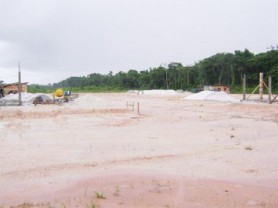-to be transit point for Brazilian goods
By Cathy Richards
A US$4 million transshipment container terminal at Christianburg, Wismar, Linden, will be the transit point for the passage of goods from Brazil to Guyana for movement into the Caribbean and beyond.
The container terminal will also facilitate the movement of goods to Brazil, particularly its northern part.
This project is being described as the biggest private sector economic activity to come on stream in Linden in recent years and is expected to encourage other spin-off industries which could play a vital role in transforming the town which is drifting away from being “a bauxite mining town”.
The project is a joint arrangement among the Guyana National Industrial Corporation (GNIC), the Linden Economic Advance-ment Programme (LEAP) and the Government of Guyana.

A team of officials from GNIC/Laparkan, Demerara Timbers Limited, and a Brazilian delegation travelled to Linden on Thursday to visit the site where the terminal is being constructed but heavy rain affected the walkabout.
However the officials briefly examined the waterfront of the OMAI Wharf which would the utilized when the business gets started.
Speaking at a briefing session in Linden on Thursday, Chairman of GNIC, Glen Khan said that when GNIC was taken over by the Laparkan Group of Companies some fourteen years ago a new vision for the company was articulated.
He said that some of the traditional businesses that were done by GNIC needed to be examined and more importantly to determine their future. “In articulating that vision we felt that the future of GNIC would be rooted in transportation and so we immediately embarked on a programme that is transport related,” Khan said.
According to Khan his company identified the constraints to Guyana’s development as being low cost domestic transportation which is done primarily by road which has been extremely expensive while the limited infrastructure in the interior provides riverine transportation.
In deliberations with LEAP and with the advent of the Takutu Bridge the management of GNIC embarked on looking at a programme which would see the setting up of the transshipment container station at Christianburg.
Khan said that the intention is to put in place a barging programme which would not only deal with the domestic needs of Guyana but that of the region as well.
“If one was to look at a number of companies whether they are into logging, mining or what have you, a lot of them have to do their own transportation by barging or what have you. Our focus is to provide that total barging solution to support a national development.”
Work on the transshipment container station project commenced in December of 2008 and is being done in several phases. The first phase was the land clearing exercise and at present infrastructural works are being done in conjunction with the construction of workshops, office buildings and living quarters.
Early in 2007 GNIC’s management led a team to Brazil which included personnel from LEAP. They visited Boa Vista, Manaus and Belem where they explored the many opportunities that existed for trade and movement between Guyana and Brazil. The team also carefully looked at the Guyana government’s intentions to open up the interior and it was realized that there would be significant development taking place, especially in the areas of agriculture and the development which is likely to take place in the intermediate savannahs.
Together with the transportation linkage with Brazil, GNIC felt that enormous economic benefit would be derived for the community of Linden.
Regional Chairman Mortimer Mingo pledged the Regional Democratic Council’s fullest support for the initiative, saying that he is aware of the benefits that it would bring to the region.
He said that last week Thursday he had discussions with his Brazilian counterparts out of Manaus who spoke for the business communities. “Coming out of that discourse that we had it was rewarding and also the interest that was generated during the discussions augurs well for the future development of Linden and Region 10,” Mingo said.





